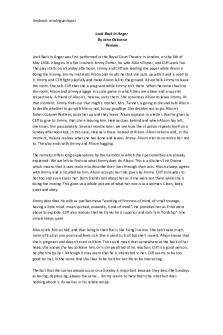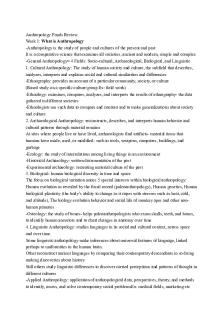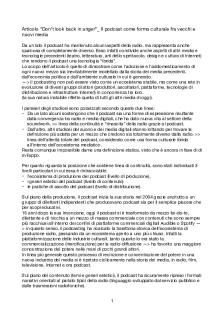Anthropology Book Review - Never In Anger PDF

| Title | Anthropology Book Review - Never In Anger |
|---|---|
| Course | INTRODUCTION TO ANTHROPOLOGY: QUESTIONS OF DIVERSITY |
| Institution | University of Aberdeen |
| Pages | 3 |
| File Size | 71.5 KB |
| File Type | |
| Total Downloads | 41 |
| Total Views | 155 |
Summary
This book review looks to analyze and evaluate the book 'Never In ~Anger' by Jean Briggs...
Description
Never In Anger Book Review
The book, “Never in Anger: Portrait on an Eskimo Family” by Jean L. Briggs offers an eyeopening analysis the way emotion is treated in comparison to the Western World through ethnographic research of an Eskimo tribe named the Utku. Briggs travelled to stay with the Utku in June 1963 and stayed for approximately seventeen months. She decided that the best way to do effective anthropological research and to fulfil her personal fascination with the Eskimos way of life was to become an “adopted daughter” of an Eskimo family as not only could she more easily learn skills and adapt to life in such unusual conditions but also view the inhabitant’s interpersonal relations more closely. One of the main focus’ of the book is the contrast between her foster father Inuttiaq family and Nilaks family. Inuttiaq’s family were viewed to be that of a traditional Eskimo family, following the assumed social etiquette exceptionally such as offering extra food to other hungry families. Inuttiaq himself was the epitome of a “good” Eskimo due to his impeccable emotional control which is valued extremely highly in their society. This was displayed in the way he “expressed himself within acceptable limits”. This means that he never outwardly expressed strong emotions such as sadness as it would be viewed as hostile toward the other inhabitants or overt happiness as this would be viewed as childish. He never made the emotions about himself and instead cantered it around others. For example, when on an excursion he would never explicitly say he missed his kids but instead that it was them who were “sad” without him. However, in contrast to this Nilak’s family is not viewed to follow the traditional way of life that is expected of them and have been ostracised and treated warily due to this. One reason being that they set up their camp far away from the rest of the Utku and not sharing excess food with the group. The real issue is the way Nilak’s wife Niqi conducts herself. She is viewed to be of less intelligence because of her apparent lack of emotional control. This is shown as she apparently has a bad temper, not keeping her anger or sadness in check like the other inhabitants. This was an effective comparison as Briggs helped highlight the way Eskimos are supposed to handle their emotions by contrasting “acceptable” and “unacceptable” behaviour; allowing the reader to greater understand the ways in which they control and limit their emotions. Children are at the centre of importance in Utku life with every adult being willing to supply them with whatever they need or want. Children are allowed to express their emotions uninhibitedly as they are viewed to be too young to be able to understand or “know any better.” However, as a child gets older, their family begins to distance themselves from them, making them learn about responsibility and reason by becoming self-reliant. Even affection is viewed as unacceptable and too childish. A prime example of this that Briggs used was Inuttiaq’s 7-year-old daughter who was left to fend for herself and was prohibited from making demands and was often ignored. The full extent of this was shown when the daughter was caught vomiting by her mother whose only reaction was a few words, never going to help or showing concern.
The Utku are a patriarchal society, the power being with the males and for them to be favoured over having female children. There is therefore apparent differences and specific roles between them with the men taking care of the wishing and the women household chores and food preparation. For example, when visitors are coming the man will inform the women to prepare tea and it is then her job to provide refills throughout the duration of the visit. As well as this, the sexes can be seen to be separate often as Inuttiaq says that it is easier to talk freely and laugh among their own sex than the other and that its simply “the way it is”. The sexes usually stay separate during meals and often throughout the day as they take care of their tasks. In conclusion, “Never in Anger” by Jean. L. Briggs” is a very well-written ethnographic research which not only gives a graphic description of the life of the Utku but is also enjoyable due to how evident her genuine intrigue is for the Eskimo way of life. The way the Eskimos show their emotions is so radically different to the Western world and gives the reader a thought-provoking insight into the way different cultures handle supposedly mundane subject such as anger.
Bibliography
Briggs, J. (1970). Never in anger ; portrait of an Eskimo family. Jean L. Briggs. Cambridge, Mass.: Harvard Univ. Press....
Similar Free PDFs

Look Back in Anger
- 2 Pages

Anthropology Exam 4 Review
- 15 Pages

Anthropology Final Review
- 11 Pages

Anthropology Exam 2 Review
- 38 Pages

Anthropology Exam 2 Review
- 8 Pages

Anthropology Finals Review
- 9 Pages

REVIEW BUKU Never Eat Alone
- 9 Pages

Book Review
- 5 Pages

Book Review
- 7 Pages

The Environment in Anthropology
- 3 Pages
Popular Institutions
- Tinajero National High School - Annex
- Politeknik Caltex Riau
- Yokohama City University
- SGT University
- University of Al-Qadisiyah
- Divine Word College of Vigan
- Techniek College Rotterdam
- Universidade de Santiago
- Universiti Teknologi MARA Cawangan Johor Kampus Pasir Gudang
- Poltekkes Kemenkes Yogyakarta
- Baguio City National High School
- Colegio san marcos
- preparatoria uno
- Centro de Bachillerato Tecnológico Industrial y de Servicios No. 107
- Dalian Maritime University
- Quang Trung Secondary School
- Colegio Tecnológico en Informática
- Corporación Regional de Educación Superior
- Grupo CEDVA
- Dar Al Uloom University
- Centro de Estudios Preuniversitarios de la Universidad Nacional de Ingeniería
- 上智大学
- Aakash International School, Nuna Majara
- San Felipe Neri Catholic School
- Kang Chiao International School - New Taipei City
- Misamis Occidental National High School
- Institución Educativa Escuela Normal Juan Ladrilleros
- Kolehiyo ng Pantukan
- Batanes State College
- Instituto Continental
- Sekolah Menengah Kejuruan Kesehatan Kaltara (Tarakan)
- Colegio de La Inmaculada Concepcion - Cebu





